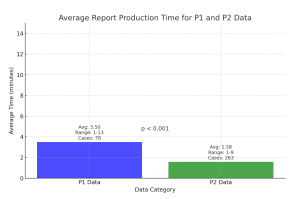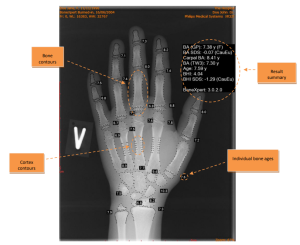The shift from manual to AI-assisted reporting resulted in a significant decrease in the time required to generate a report. The mean reporting time in Phase 1 was 3.5 minutes, with a range of 1 to 13 minutes, whereas in Phase 2, the mean time decreased to 1.58 minutes, with a range of 1 to 9 minutes. This represents a 55% reduction in reporting time, demonstrating the efficiency of AI-assisted reporting (p < 0.001). Figure 1 illustrates this reduction, showing the comparison between the two phases.

A statistical summary of these findings is presented in Table 1.

Beyond efficiency improvements, AI-assisted assessment provides automated and standardized bone age interpretation, reducing the likelihood of human error and improving workflow consistency across multiple centers. Figure 2 shows an example of a BoneXpert analysis, illustrating the automated bone age determination.
